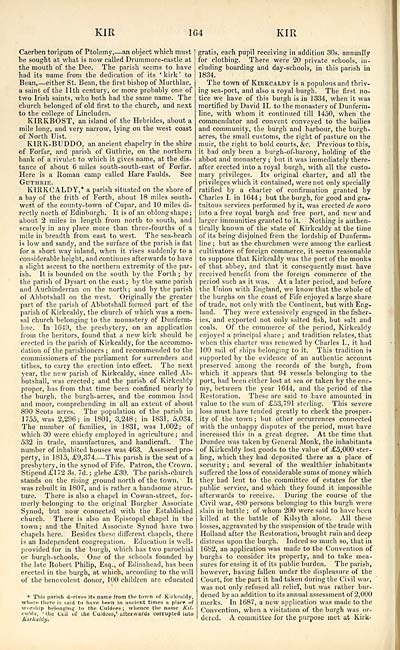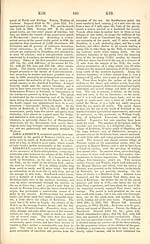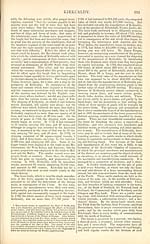Topographical, statistical, and historical gazetteer of Scotland > Volume 2
(176) Page 164
Download files
Complete book:
Individual page:
Thumbnail gallery: Grid view | List view

KIR
1G4
KIR
Caerben torigum of Ptolemy, — an object which must
be sought at what is now called Drummore-castle at
the mouth of the Dee. The parish seems to have
had its name from the dedication of its 'kirk' to
Bean,— either St. Bean, the first bishop of Murthlac,
a saint of the 11th century, or more probably one of
two Irish saints, who both had the same name. The
church belonged of old first to the church, and next
to the college of Lincluden.
KIRKBOST, an island of the Hebrides, about a
mile long, and very narrow, lying on the west coast
of North Uist.
KIRK-BUDDO, an ancient chapelry in the shire
of Forfar, and parish of Guthrie, on the northern
bank of a rivulet to which it gives name, at the dis-
tance of about 6 miles south-south-east of Forfar.
Here is a Roman camp called Hare Faulds. See
Guthrie.
KIRKCALDY,* a parish situated on the shore of
a bay of the frith of Forth, about 18 miles south-
west of the county-town of Cupar, and 10 miles di-
rectly north of Edinburgh. It is of an oblong shape ;
about 2 miles in length from north to south, and
scarcely in any place more than three-fourths of a
mile in breadth from east to west. The sea-beach
is low and sandy, and the surface of the parish is flat
for a short way inland, when it rises suddenly to a
considerable height, and continues afterwards to have
a slight ascent to the northern extremity of the par-
ish. It is bounded on the south by the Forth ; by
the parish of Dysart on the east ; by the same parish
and Auchinderran on the north; and by the parish
of Abbotshall on the west. Originally the greater
part of the parish of Abbotshall formed part of the
parish of Kirkcaldy, the church of which was a men-
sal church belonging to the monastery of Dunferm-
line. In 1640, the presbytery, on an application
from the heritors, found that a new kirk should be
erected in the parish of Kirkcaldy, for the accommo-
dation of the parishioners ; and recommended to the
commissioners of the parliament for surrenders and
tithes, to carry the erection into effect. The next
year, the new parish of Kirkcaldy, since called Ab-
botshall, was erected ; and the parish of Kirkcaldy
proper, has from that time been confined nearly to
the burgh, the burgh-acres, and the common land
and moor, comprehending in all an extent of about
890 Scots acres. The population of the parish in
1755, was 2,296; in 1801, 3,248; in 1831, 5,034.
The number of families, in 1831, was 1.002; of
which 30 were chiefly employed in agriculture; and
532 in trade, manufactures, and handicraft. The
number of inhabited houses was 463. Assessed pro-
perty, in 1815, £9,374 This parish is the seat of a
presbytery, in the synod of Fife. Patron, the Crown.
Stipend£l72 3s. 7d.; glebe £30. The parish-church
stands on the rising ground north of the town. ' It
was rebuilt in 1807, and is rather a handsome struc-
ture. There is also a chapel in Cowan-street, for-
merly belonging to the original Burgher Associate
Synod, but now connected with the Established
church. There is also an Episcopal chapel in the
town; and the United Associate Synod have two
chapels here. Besides these different chapels, there
is an Independent congregation. Education is well-
provided for in the burgh, which has two parochial
or burgh-schools. One of the schools founded by
the late Robert Philip, Esq., of Edinshead, has been
erected in the burgh, at which, according to the will
of the benevolent donor, 100 children are educated
* This parish derives its name from the town of Kirkcaldy,
where there is said to have heen in aoeient times a plar« of
worship belonfrine; to the Culdees; whence the name Kit.
cn/da, ' the Cell of llie Culdees,' afterwards corrupted iuto
Kirkaldy,
gratis, each pupil receiving in addition 30s. annually
for clothing. There were 20 private schools, in-
cluding boarding and day-schools, in this parish in
1834.
The town of Kirkcaldy is a populous and thriv-
ing sea-port, and also a royal burgh. The first no-
tice we have of this burgh is in 1334, when it was
mortified by David II. to the monastery of Dunferm-
line, with whom it continued till 1450, when the
commendator and convent conveyed to the bailies
and community, the burgh and harbour, the burgh-
acres, the small customs, the right of pasture on the
muir, the right to hold courts, &c. Previous to this,
it had only been a burgh-of-barony, holding of the
abbot and monastery ; but it was immediately there-
after erected into a royal burgh, with all the custo-
mary privileges. Its original charter, and all the
privileges which it contained, were not only specially
ratified by a charter of confirmation granted by
Charles I. in 1644; but the burgh, for good and gra-
tuitous services performed by it, was erected de novo
into a free royal burgh and free port, and new and
larger immunities granted to it. Nothing is authen-
tically known of the state of Kirkcaldy at the time
of its being disjoined from the lordship of Dunferm-
line ; but as the churchmen were among the earliest
cultivators of foreign commerce, it seems reasonable
to suppose that Kirkcaldy was the port of the monks
of that abbey, and that it consequently must have
received benefit from the foreign commerce of the
period such as it was. At a later period, and before
the Union with England, we know that the whole of
the burghs on the coast of Fife enjoyed a large share
of trade, not only with the Continent, but with Eng-
land. They were extensively engaged in the fisher-
ies, and exported not only salted fish, but salt and
coals. Of the commerce of the period, Kirkcaldy
enjoyed a principal share ; and tradition relates, that
when this charter was renewed by Charles I., it had
100 sail of ships belonging to it. This tradition is
supported by the evidence of an authentic account
preserved among the records of the burgh, from
which it appears that 94 vessels belonging to the
port, had been either lost at sea or taken by the ene-
my, between the year 1644, and the period of the
Restoration. These are said to have amounted in
value to the sum of £53,791 sterling. This severe
loss must have tended greatly to check the prosper-
ity of the town ; but other occurrences connected
with the unhappy disputes of the period, must have
increased this in a great degree. At the time that
Dundee was taken by General Monk, the inhabitants
of Kirkcaldy lost goods to the value of £5,000 ster-
ling, which they had deposited there as a place of
security; and several of the wealthier inhabitants
suffered the loss of considerable sums of money which
they had lent to the committee of estates for the
public service, and which they found it impossible
afterwards to receive. During the course of the
Civil war, 480 persons belonging to this burgh were
slain in battle ; of whom 200 were said to have been
killed at the battle of Kilsyth alone. All these
losses, aggravated by the suspension of the trade with
Holland after the Restoration, brought ruin and deep
distress upon the burgh. Indeed so much so, that in
1682, an application was made to the Convention of
burghs to consider its property, and to take mea-
sures for easing it of its public burden. The parish,
however, having fallen under the displeasure of the
Court, for the part it had taken during the Civil war,
was not only refused all relief, but was rather bur-
dened by an addition to its annual assessment of 2,000
merks. In 1687, a new application was made to the
Convention, when a visitation of the burgh was or-
dered. A committee for the purpose met at Kirk-
1G4
KIR
Caerben torigum of Ptolemy, — an object which must
be sought at what is now called Drummore-castle at
the mouth of the Dee. The parish seems to have
had its name from the dedication of its 'kirk' to
Bean,— either St. Bean, the first bishop of Murthlac,
a saint of the 11th century, or more probably one of
two Irish saints, who both had the same name. The
church belonged of old first to the church, and next
to the college of Lincluden.
KIRKBOST, an island of the Hebrides, about a
mile long, and very narrow, lying on the west coast
of North Uist.
KIRK-BUDDO, an ancient chapelry in the shire
of Forfar, and parish of Guthrie, on the northern
bank of a rivulet to which it gives name, at the dis-
tance of about 6 miles south-south-east of Forfar.
Here is a Roman camp called Hare Faulds. See
Guthrie.
KIRKCALDY,* a parish situated on the shore of
a bay of the frith of Forth, about 18 miles south-
west of the county-town of Cupar, and 10 miles di-
rectly north of Edinburgh. It is of an oblong shape ;
about 2 miles in length from north to south, and
scarcely in any place more than three-fourths of a
mile in breadth from east to west. The sea-beach
is low and sandy, and the surface of the parish is flat
for a short way inland, when it rises suddenly to a
considerable height, and continues afterwards to have
a slight ascent to the northern extremity of the par-
ish. It is bounded on the south by the Forth ; by
the parish of Dysart on the east ; by the same parish
and Auchinderran on the north; and by the parish
of Abbotshall on the west. Originally the greater
part of the parish of Abbotshall formed part of the
parish of Kirkcaldy, the church of which was a men-
sal church belonging to the monastery of Dunferm-
line. In 1640, the presbytery, on an application
from the heritors, found that a new kirk should be
erected in the parish of Kirkcaldy, for the accommo-
dation of the parishioners ; and recommended to the
commissioners of the parliament for surrenders and
tithes, to carry the erection into effect. The next
year, the new parish of Kirkcaldy, since called Ab-
botshall, was erected ; and the parish of Kirkcaldy
proper, has from that time been confined nearly to
the burgh, the burgh-acres, and the common land
and moor, comprehending in all an extent of about
890 Scots acres. The population of the parish in
1755, was 2,296; in 1801, 3,248; in 1831, 5,034.
The number of families, in 1831, was 1.002; of
which 30 were chiefly employed in agriculture; and
532 in trade, manufactures, and handicraft. The
number of inhabited houses was 463. Assessed pro-
perty, in 1815, £9,374 This parish is the seat of a
presbytery, in the synod of Fife. Patron, the Crown.
Stipend£l72 3s. 7d.; glebe £30. The parish-church
stands on the rising ground north of the town. ' It
was rebuilt in 1807, and is rather a handsome struc-
ture. There is also a chapel in Cowan-street, for-
merly belonging to the original Burgher Associate
Synod, but now connected with the Established
church. There is also an Episcopal chapel in the
town; and the United Associate Synod have two
chapels here. Besides these different chapels, there
is an Independent congregation. Education is well-
provided for in the burgh, which has two parochial
or burgh-schools. One of the schools founded by
the late Robert Philip, Esq., of Edinshead, has been
erected in the burgh, at which, according to the will
of the benevolent donor, 100 children are educated
* This parish derives its name from the town of Kirkcaldy,
where there is said to have heen in aoeient times a plar« of
worship belonfrine; to the Culdees; whence the name Kit.
cn/da, ' the Cell of llie Culdees,' afterwards corrupted iuto
Kirkaldy,
gratis, each pupil receiving in addition 30s. annually
for clothing. There were 20 private schools, in-
cluding boarding and day-schools, in this parish in
1834.
The town of Kirkcaldy is a populous and thriv-
ing sea-port, and also a royal burgh. The first no-
tice we have of this burgh is in 1334, when it was
mortified by David II. to the monastery of Dunferm-
line, with whom it continued till 1450, when the
commendator and convent conveyed to the bailies
and community, the burgh and harbour, the burgh-
acres, the small customs, the right of pasture on the
muir, the right to hold courts, &c. Previous to this,
it had only been a burgh-of-barony, holding of the
abbot and monastery ; but it was immediately there-
after erected into a royal burgh, with all the custo-
mary privileges. Its original charter, and all the
privileges which it contained, were not only specially
ratified by a charter of confirmation granted by
Charles I. in 1644; but the burgh, for good and gra-
tuitous services performed by it, was erected de novo
into a free royal burgh and free port, and new and
larger immunities granted to it. Nothing is authen-
tically known of the state of Kirkcaldy at the time
of its being disjoined from the lordship of Dunferm-
line ; but as the churchmen were among the earliest
cultivators of foreign commerce, it seems reasonable
to suppose that Kirkcaldy was the port of the monks
of that abbey, and that it consequently must have
received benefit from the foreign commerce of the
period such as it was. At a later period, and before
the Union with England, we know that the whole of
the burghs on the coast of Fife enjoyed a large share
of trade, not only with the Continent, but with Eng-
land. They were extensively engaged in the fisher-
ies, and exported not only salted fish, but salt and
coals. Of the commerce of the period, Kirkcaldy
enjoyed a principal share ; and tradition relates, that
when this charter was renewed by Charles I., it had
100 sail of ships belonging to it. This tradition is
supported by the evidence of an authentic account
preserved among the records of the burgh, from
which it appears that 94 vessels belonging to the
port, had been either lost at sea or taken by the ene-
my, between the year 1644, and the period of the
Restoration. These are said to have amounted in
value to the sum of £53,791 sterling. This severe
loss must have tended greatly to check the prosper-
ity of the town ; but other occurrences connected
with the unhappy disputes of the period, must have
increased this in a great degree. At the time that
Dundee was taken by General Monk, the inhabitants
of Kirkcaldy lost goods to the value of £5,000 ster-
ling, which they had deposited there as a place of
security; and several of the wealthier inhabitants
suffered the loss of considerable sums of money which
they had lent to the committee of estates for the
public service, and which they found it impossible
afterwards to receive. During the course of the
Civil war, 480 persons belonging to this burgh were
slain in battle ; of whom 200 were said to have been
killed at the battle of Kilsyth alone. All these
losses, aggravated by the suspension of the trade with
Holland after the Restoration, brought ruin and deep
distress upon the burgh. Indeed so much so, that in
1682, an application was made to the Convention of
burghs to consider its property, and to take mea-
sures for easing it of its public burden. The parish,
however, having fallen under the displeasure of the
Court, for the part it had taken during the Civil war,
was not only refused all relief, but was rather bur-
dened by an addition to its annual assessment of 2,000
merks. In 1687, a new application was made to the
Convention, when a visitation of the burgh was or-
dered. A committee for the purpose met at Kirk-
Set display mode to: Large image | Transcription
Images and transcriptions on this page, including medium image downloads, may be used under the Creative Commons Attribution 4.0 International Licence unless otherwise stated. ![]()
| Gazetteers of Scotland, 1803-1901 > Topographical, statistical, and historical gazetteer of Scotland > Volume 2 > (176) Page 164 |
|---|
| Permanent URL | https://digital.nls.uk/97450702 |
|---|
| Description | Volume second: I-Z. |
|---|---|
| Shelfmark | Map Room Ref.2 |
| Attribution and copyright: |
|

